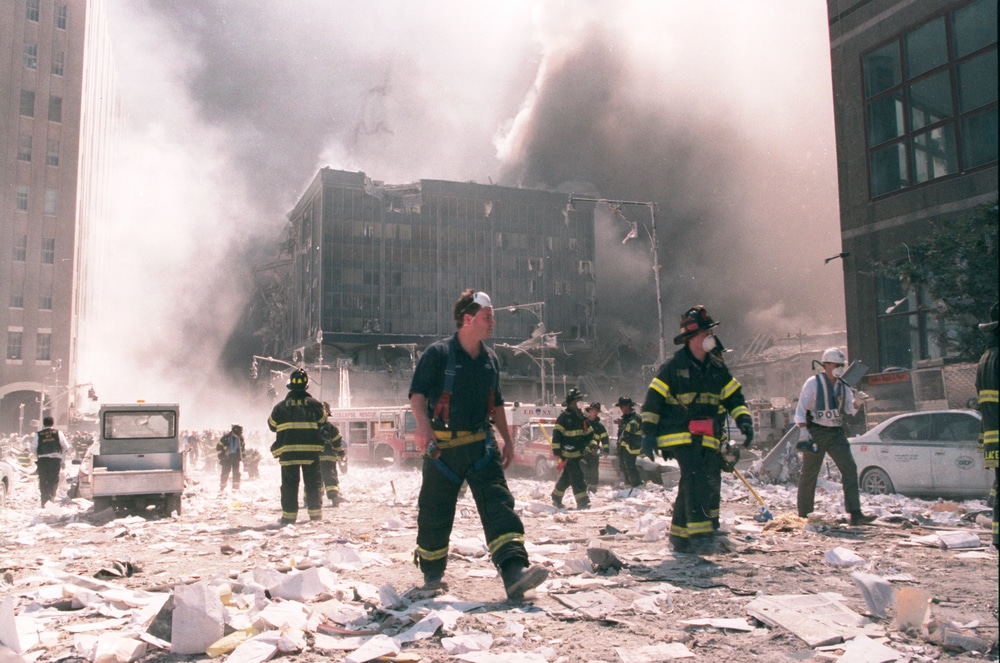The terrorist attacks on the World Trade Center and other sites reined death and destruction, shaking America to its core. Months and years later, the health effects of the disaster became clear, as asbestos and other toxic chemicals in the air and pile of rubble gave rise to deadly diseases. First responders and others in the vicinity of the Twin Towers began showing symptoms of asbestos-related diseases, including malignant mesothelioma and lung cancer.

The World Trade Center and September 11th
On September 11, 2001, the Islamist extremist group al-Qaeda carried out a terrorist attack against the United States. Nineteen terrorists hijacked four commercial airplanes with the plan of crashing them into multiple sites across the country. Two of the planes flew into the North and South Towers of the World Trade Center complex, a third crashed into the Pentagon in Arlington, Virginia, and the fourth plane, Flight 93, crashed into an empty field in western Pennsylvania after passengers fought back against the hijackers. In all, the day ended in the deaths of 2,977 people: 2,753 in New York, 184 at the Pentagon, and 40 onboard Flight 93.[1]
At the World Trade Center, one of the planes crashed into the North Tower, directly striking the 93rd to 99thfloors, while the other struck the South Tower’s 77th to 85th floors. Most of the roughly 18,000 people in the buildings were able to be evacuated down the same stairwells that first responders were climbing in an effort to save those left behind. Jet fuel from the planes added to the fires from the impact, weakening the building’s support trusses and leading to the devastating collapse of both buildings as well as five others that surrounded it.[1]
In the days, weeks, and months that followed, thousands of first responders and other volunteers came to the site, now called Ground Zero, to assist with recovery and clean-up. The entire process took nearly a year.[1]
Asbestos in the World Trade Center
The North and South Tower of the World Trade Center, also known as the Twin Towers, were the tallest buildings in New York City and part of a seven-building, 16-acre commercial complex in lower Manhattan. Completed in 1973, for a time they were the tallest buildings in the world and served as a powerful landmark and attraction in New York. The building was so large that it required 99 elevators to accommodate its occupants, and each floor measured a full acre.[1]
It took several years for the World Trade Center to be constructed, and during much of the time that it took for the buildings to go up, asbestos was a common component of construction. Early in the Twin Towers’ construction, a mixture containing roughly 20 percent asbestos was sprayed onto steel beams, where it dried and formed an insulating layer. By the time concerns over the toxicity forced the Port Authority to switch to a substitute fireproofing material that didn’t contain asbestos, forty floors of the North Tower had already been built.[2] This asbestos, as well as other asbestos-containing materials that were known to have been used throughout the structure before having been banned in New York City, were found in the dust at Ground Zero.[3]
Study Confirms the Risk of Asbestos Exposure Following 9/11
After the fall of the Twin Towers, multiple environmental studies were conducted to determine the health effects arising from the rubble pile and airborne dust. This was a concern for workers who were searching for remains and clearing debris, as well as for occupants of the area. One study conducted by researchers from the Arnhold Institute for Global Health at the Icahn School of Medicine at Mount Sinai in New Yorkdetermined that concentrations of asbestos in the dust at Ground Zero varied based on the location where the samples were taken and the composition of the dust in each area.[3]
The researchers concluded that workers had intermittent and unpredictable exposures and that their risk of asbestos-related disease was exacerbated by the fact that the U.S. Occupational Safety and Health Administration (OSHA) had failed to require constant use of respirators for those working at the disaster site. The study’s authors expressed concern about the risk of malignant mesothelioma caused by occupational exposure to asbestos among those who worked and volunteered at Ground Zero and noted that previous pathologic studies had found that the chrysotile fibers that had been prevalent at Ground Zero were the predominant fiber in mesothelioma tissue. They also noted that mesothelioma had been reported in people who’d experienced relatively low-dose, nonoccupational exposure to asbestos, even if it was of brief duration.[3]
Who Was at Risk of Asbestos Exposure Following 9/11?
The area of Manhattan where the World Trade Center stood was a hub of activity before the attacks, and many people who lived, worked, and visited the area on the day of the attack and in the days and weeks after would have been exposed to the asbestos that hung in the air following the building’s collapse. Even greater exposure would have been experienced by anybody actively working in the debris pile. Those at risk included:
- Communications recovery workers
- Construction workers
- Teachers and students in nearby schools
- Employees in nearby buildings
- First responders
- Health professionals caring for those working on the debris pile
- Clean-up workers
- Residents
- Tourists
- World Trade Center employees
- Firefighters
- Paramedics
- Police officers
- Search and rescue workers
In addition to the risk faced by anybody who frequented the Ground Zero area, family members of those who worked or volunteered for the recovery and clean-up effort were also endangered by the toxic dust that was carried home on their loved one’s hair, skin, and clothing when they returned home each day. This type of secondary asbestos exposure has proven to be a significant risk factor for mesothelioma and other illnesses.
Health Effects from Exposure to World Trade Center Debris and Dust
Just two months after the World Trade Center disaster, the New York City Health Department helped create a registry dedicated to tracking, documenting, and investigating the health effects created by the events of September 11th. At the time, it was estimated that approximately 400,000 people would be eligible for the federally funded registry, including building occupants and others in the area, rescue and recovery workers and volunteers, residents, and children and staff in the area’s schools.[4]
In the years that followed the event, multiple surveys of adults, adolescents, and children have been conducted and have identified over 100 conditions directly related to the 9/11 disaster. These include:[4]
- Acute traumatic injuries
- Aerodigestive disorders
- Multiple cancers
- Mental health conditions
- Musculoskeletal disorders
As early as one month after the Twin Towers fell, clinicians caring for the firefighters and other first responders serving at Ground Zero described what they called WTC cough and called for investigations and intervention. New York City provided limited funds, which were expanded through philanthropic efforts. Federal funding was later provided to allow the Fire Department of New York and the Mount Sinai School of Medicine to provide one-time health screening of these responders.[5]
By 2002, others in the neighborhood were coughing, wheezing, and experiencing shortness of breath. Residents created a coalition called Beyond Ground Zero, which partners with the American Red Cross and the city to create the WTC Environmental Health Center at Bellevue Hospital. In 2004, these efforts were expanded by Congress, with the National Institute for Occupational Safety and Health providing periodic medical monitoring of responders. The combined efforts of these groups identified persistent health problems that led to congressional funding to cover treatment costs, and this eventually led to the passage of the James Zadroga 9/11 Health and Compensation Act of 2010, which pays for continued screening and medical care for survivors, including residents, local workers, students, and others harmed by the 9/11 terror attacks.[5]
Mesothelioma and September 11th Asbestos
By 2016, the medical director of the WTC Health Program issued a statement reporting that there had been over 5,400 Ground Zero first responders and citizens diagnosed with cancer-related to the fall of the towers. That number had tripled over the previous two and half years, with several of the victims being diagnosed with more than one type of cancer. Though at the time, the most frequently diagnosed malignancies were prostate cancer, thyroid cancer, leukemia, lymphoma, and multiple myeloma, oncologists treating those who’d been in the area began bracing for a significant uptick in the years to come and began predicting a surge in mesothelioma diagnoses beginning around 2041, in keeping with the asbestos-related disease’s long latency period.
As early as 2004, Philip Landrigan predicted that firefighters on the site would be at risk of mesothelioma.[”3”] By 2019, 52-year-old Pittsburgh native Nick Ursta had succumbed to the disease. He’d headed to New York City the night of the attacks along with his wife and nine other members of the White Oak Rescue squad. Stationed within a block of Ground Zero, they were constantly breathing in asbestos-contaminated dust for three days. Dr. Michael Crane, medical director of the World Trade Center Health Program at Mount Sinai Hospital, said that Mr. Ursta’s diagnosis was just the beginning of what was likely to be a trend. Dr. Crane said, “I hope this will remain occasional and very rare, but we are all concerned about that pathway to lung cancer and mesothelioma. It’s something we must keep an eye on.”
Compensation for Those Affected by 9/11 Asbestos
In addition to federal compensation for victims of illnesses following 9/11, there have been multiple lawsuits and settlements related to asbestos exposure from the World Trade Center. These include:
- In 2010, thousands of rescue and recovery workers accepted a $713 million court settlement for asbestos dust-related injuries. The settlement arranged for the WTC Captive Insurance fund to pay the claims, with some workers’ compensation liens against the settlement recovery being waived and claimants receiving damages on a sliding scale based on the severity of their injuries. The highest-level plaintiffs received as much as $1 million.[6]
- A settlement between the Porty Authority of New York and New Jersey provided $47.5 million to a separate group of plaintiffs who claimed they were injured or suffered illness after participating in the cleanup after the attacks.[7]
References
- 9/11 Memorial & Museum. (N.D.). 9/11 FAQs
Retrieved from: https://www.911memorial.org/911-faqs - The New York Times. (September 28, 2001.). A NATION CHALLENGED; Haunting Question: Did the Ban on Asbestos Lead to Loss of Life?
Retrieved from: https://www.nytimes.com/2001/09/18/science/nation-challenged-haunting-question-did-ban-asbestos-lead-loss-life.html - NIH, National Library of Medicine. (August, 2004.). The WTC Disaster: Landrigan’s Response.
Retrieved from: https://pmc.ncbi.nlm.nih.gov/articles/PMC1247504/ - NYC 9/11 Health. (N.D.). World Trade Center Health Registry.
Retrieved from: https://www.nyc.gov/site/911health/about/wtc-health-registry.page - CDC. (N.D.). 9-11 World Trade Center Health Program: Toxins and Health Impacts.
Retrieved from: https://www.cdc.gov/wtc/exhibition/toxins-and-health-impacts.html - Law360. (June 10, 2010.). Judge OKs $713M Settlement For WTC Rescue Workers.
Retrieved from: https://www.law360.com/articles/174405/judge-oks-713m-settlement-for-wtc-rescue-workers - Law.com. Judge OKs $47.5 Million Settlement Between Port Authority, 9/11 Plaintiffs
Retrieved from: https://www.law.com/almID/1202473482161/

Terri Heimann Oppenheimer
WriterTerri Oppenheimer has been writing about mesothelioma and asbestos topics for over ten years. She has a degree in English from the College of William and Mary. Terri’s experience as the head writer of our Mesothelioma.net news blog gives her a wealth of knowledge which she brings to all Mesothelioma.net articles she authors.

Dave Foster
Page EditorDave has been a mesothelioma Patient Advocate for over 10 years. He consistently attends all major national and international mesothelioma meetings. In doing so, he is able to stay on top of the latest treatments, clinical trials, and research results. He also personally meets with mesothelioma patients and their families and connects them with the best medical specialists and legal representatives available.


